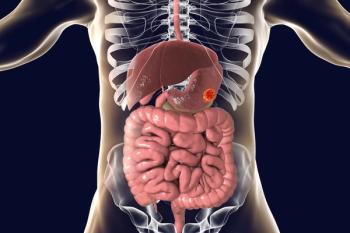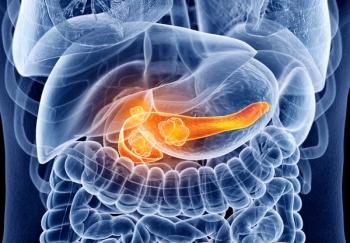
- ONCOLOGY Vol 17 No 11
- Volume 17
- Issue 11
Commentary (Palesty et al)-Imatinib Mesylate: A Molecularly Targeted Therapy for Gastrointestinal Stromal Tumors
Dr. Eisenberg has produced anexcellent, concise, yet comprehensivereview of the evolutionof the KIT inhibitor imatinibmesylate (Gleevec) and the preoperativeand postoperative treatmentdilemmas surrounding mesenchymalgastrointestinal stromal tumors(GISTs), particularly in the face ofadvanced disease and recurrences. Thefocus of the article is on the naturalhistory of GISTs, from a molecularand pathobiologic perspective, toclarify the rationale for the use ofimatinib.
Dr. Eisenberg has produced an excellent, concise, yet comprehensive review of the evolution of the KIT inhibitor imatinib mesylate (Gleevec) and the preoperative and postoperative treatment dilemmas surrounding mesenchymal gastrointestinal stromal tumors (GISTs), particularly in the face of advanced disease and recurrences. The focus of the article is on the natural history of GISTs, from a molecular and pathobiologic perspective, to clarify the rationale for the use of imatinib.
The author effectively addresses the controversies surrounding imatinib use in the preoperative and postoperative treatment of GISTs, with an emphasis on recurrence in the face of previous surgical extirpation. An elegant discussion of the proposed biologic and genetic mechanisms involved in tumor response and resistance provides insight into the possible scientific and medical trends that may emerge from discoveries in these arenas and the ultimate amalgamation of the bench-to-bedside and bedside-tobench paradigms. The conclusions drawn with regard to the future of molecularly specific chemotherapeutic agents in cancer therapy are both provocative and insightful.
GIST and Imatinib
Prior to the conception of imatinib, the treatment of GISTs was a frustrating endeavor for both clinician and patient because of the unrelenting and progressive nature of the disease regardless of the therapy used, ie, surgical extirpation, chemotherapy, or radiation. Even when surgery was "successful" (negative margins were achieved using meticulous technique and avoiding intraoperative tumor rupture), the recurrence rate was 40% to 80%, with a median time to recurrence of 1.5 to 2 years.[1,2] Characteristics associated with an increased risk of recurrence include tumor size, location, and mitotic rate.[3] In adjuvant and neoadjuvant trials, imatinib is effective and well-tolerated and is anticipated to emerge as the standard treatment for both primary and recurrent GISTs, either alone, in conjunction with surgery, or as part of a multimodality, target-specific "designer" drug regimen.[4-6]
Imatinib as a Neoadjuvant Agent
Our limited experience with imatinib as a neoadjuvant agent has been extremely rewarding and has certainly decreased the potential morbidities associated with surgery. One elderly, frail patient with a pathologically documented GIST who presented with a complex enterocutaneous fistula and large bulky disease of the small bowel initially received preoperative imatinib. A positron-emission tomography (PET) scan performed 7 days after the initiation of therapy went from grossly positive to essentially nonreactive, with glycolytic activity limited to the periphery of the tumor. At 8 weeks after neoadjuvant therapy, it was apparent intraoperatively that the center of the mass had undergone necrosis. Interestingly, a mesenteric lymph node returned with metastatic disease. The patient continues to take imatinib postoperatively with no side effects.
A second patient presented with a rectal mass that was biopsied and shown to be a GIST. It was felt that she would require an abdominoperineal resection to completely remove her disease. She elected to try imatinib and, after 8 weeks of treatment, the dramatic tumor shrinkage allowed her to undergo a transanal excision with negative margins and preservation of her sphincter. These cases clearly demonstrate the potential utility of neoadjuvant imatinib therapy.
Response, Resistance, and the Search for a Cytotoxic Agent
Although early evidence from clinical trials overwhelmingly points to the effectiveness of imatinib, the previous two cases illustrate some of the unresolved quandaries.[4-6] These dilemmas are addressed thoroughly by Dr. Eisenberg, who further elucidates the oncogenesis of GISTs and investigates the mechanisms responsible for the variety of responses associated with GISTs, as well as their ability to acquire resistance to imatinib.
The discovery that the genetic location of the c-kit mutation is directly correlated to the tumor's responsiveness demonstrates the need for further investigation of targeted therapies to create a lethal, rather than a "static" drug; current evidence suggests that imatinib is more of a "static" than "toxic" drug, as demonstrated by both the varied clinical response times and glycolytic activity on PET.[7-10] Alternative or combination drug therapy targeting the multiple KIT kinase pathways-for example, SU11248- may be a promising temporizing maneuver to overcome resistance to imatinib while searching for a more toxic agent.[11] The focus on cellular targets in the tyrosine kinase pathway reflects a new movement in cancer care. Rather than concentrating on eradication of the disease, many investigators are seeking to control disease progression and prevent drug resistance so that cancer patients may live in symbiosis with their disease.
Dr. Eisenberg is the principle investigator of the Radiation Therapy Oncology Group protocol S-0132, which will focus on collecting and examining tissue from patients with primary and recurrent GISTs, both before and after imatinib treatment. This will facilitate the creation of a large repository of tissue for comparing pre- and posttreatment specimens through an analysis of c-kit, other signaling molecules, and gene mutations, which should help elucidate the biologic effects of imatinib as well as the causes of responsiveness and resistance. The effectiveness of imatinib treatment will be evaluated clinically with PET and 18-fluorodeoxyglucose PET to assess the ability of these techniques to accurately provide information on tumor responsiveness.
Ideally, the findings from this protocol will allow for identification of those patients who will likely respond to imatinib and those who may need treatment with an alternative tyrosine kinase inhibitor. Perhaps patients who will remain progression-free and those who will develop resistance to imatinib can also be identified. This trial's discoveries may assist in predicting the biologic behavior of individual GISTs, allowing for a focused therapeutic plan and, thereby, increasing disease-free and possible overall survival.
Imatinib and the Future of Cancer Therapy
The oncogenesis, evolution, pathobiology, and treatment of GIST are dynamic frontiers of inquiry, with many issues that need clarification before effective control and/or eradication of the disease with rational, cellspecific treatment can ensue. Imatinib and the implications of what has been discovered about its mechanisms have catapulted oncologic research into a new era. The bench-to-bedside paradigm that has been established with the development of imatinib, from initial research in chronic myelogenous leukemia, to its subsequent application to GISTs, has proven the value of working backward.
The ability to identify a specific microbiologic abnormality and design an exclusive therapy for it has shifted the emphasis away from poisoning the entire system with the expectation that malignant cells will be affected. This new model of investigation needs to be transposed into other areas of translational research so that cancer management can effectively progress. Targeted molecular or genetic therapy will eliminate trial and error from this aspect of medicine and transform it from an art into a hard science. Imatinib and its implications are exciting because such therapy may represent the final gateway in the advance toward realizing Ehrlich's "magic bullet" and the dawn of the era of truly useful designer drugs.
Financial Disclosure:The author(s) have no significant financial interest or other relationship with the manufacturers of any products or providers of any service mentioned in this article.
References:
1. DeMatteo RP, Lewis JJ, Leung D, et al: Two hundred gastrointestinal stromal tumors: Recurrence patterns and prognostic factors for survival. Ann Surg 231:51-58, 2000.
2. Joensuu H, Fletcher C, Dimitrijevic S, et al: Management of malignant gastrointestinal stromal tumours. Lancet Oncol 3:655-664, 2002.
3. Suster S: Gastrointestinal stromal tumors. Semin Diagn Pathol 13:297-313, 1996.
4. Demetri GD, von Mehren M, Blanke CD, et al: Efficacy and safety of imatinib mesylate in advanced gastrointestinal stromal tumors. N Engl J Med 347:472-480, 2002.
5. von Mehren M, Blanke C, Joensuu H, et al: High incidence of durable responses induced by imatinib mesylate in patients with unresectable and metastatic gastrointestinal stromal tumor (abstract 1608). Proc Am Soc Clin Oncol 21:403a, 2002.
6. Benjamin RS, Rankin C, Fletcher C, et al: Phase III dose randomized study of imatinib mesylate (STI571) for GIST: Intergroup S0033 early results (abstract 3271). Proc Am Soc Clin Oncol 22:814, 2003.
7. Heinrich MC, Corless CL, Duensing A, et al: PDGFRA activating mutations in gastrointestinal stromal tumors. Science 299:708- 710, 2003.
8. Heinrich MC, Corless CL, von Mehren, et al: PDGFRA and KIT mutations correlate with the clinical responses to imatinib mesylate in patients with advanced gastrointestinal stomal tumors (GIST) (abstract 3274). Proc Am Soc Clin Oncol 2003.
9. Fletcher J, Corless C, Dimitrijevic S, et al: Mechanisms of resistance to imatinib mesylate in advanced gastrointestinal stromal tumor (GIST) (abstract 3275). Proc Am Soc Clin Oncol 22:815, 2003.
10. van den Abbeele, Badawi R: Use of positron-emission tomography in oncology and its potential role to assess response to imatinib mesylate therapy in gastrointestinal stromal tumors (GIST). Eur J Cancer 38(suppl 5):S60- S65, 2002.
11. Demetri G, George S, Heinrich MC, et al: Clinical activity and tolerability of the multitargeted tyrosine kinase inhibitor SU11248 in patients with metastatic gastrointestinal stromal tumor (GIST) refractory to imatinib mesylate (abstract 3273). Proc Am Soc Clin Oncol 22:814, 2003.
Articles in this issue
about 22 years ago
Erlotinib: Preclinical Investigationsabout 22 years ago
Ovarian Tumors of Low Malignant Potentialabout 22 years ago
Risk Assessment in Oncology Clinical PracticeNewsletter
Stay up to date on recent advances in the multidisciplinary approach to cancer.

















































































